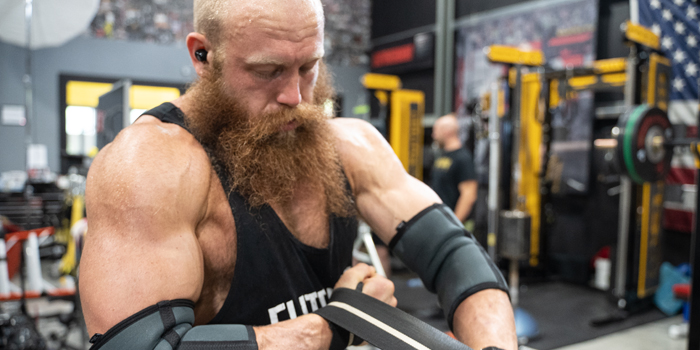
After the age of 30, many of us guys become dads. While the twenties were flooded with training volume and intensities we glorified, the sudden new decade may have quickly crept up on you, especially if you became a father.
The biggest mistake many of us make is trying to match or compare ourselves to what we used to do in terms of training. From a personal standpoint, I've learned the hard way how quickly two newborns in under two years can be a sudden change to your fitness routine…
So take note on these training misconceptions you need to come to reality with:
1. Matching Your Training Frequency
This one makes me chuckle the most, quite honestly. I hear new dads all the time tell me how they will be training the same and working with the same intensity when they become daddies. It's nothing short of a recipe for disaster.
Fatherhood comes with more responsibility, more stress, and less sleep. Let's say it how it is, you will be tired. Any father who tells you differently either has a saint for a wife or takes more naps than the babies themselves.
READ: The Dark Side of Personal Training
Your training days need to be intense, but they won't be as often. Expect to cut back to three to four days a week if you are a six-day attendee. I'm not saying here that you cannot train six days, but the effort and intensity that would go into these added workouts will either do two things:
- Increase stress response and inflammation to your already run down body, making your life more exhausting and you being less help in other dad duties (trust me, you don’t want to be slacking in that area for your wife).
- Add junk volume that will create more systematic fatigue that makes your recovery harder.
You can prove me wrong if you wish, but I lived to tell the tale. I might have six great workouts during the week, but I am either nonexistent on the support side for my wife or the productive side for my business. Most of us don't have lives we can slack in either of those areas, so you can trend lightly with your choice.
My Suggestion:
Five-day splits aren't practical or sustainable. Dads don't have the time to be in the gym for an hour or more than five days a week. I've found shorter workouts work best, and a 2010 study did some digging on frequency and muscle growth and found repeated bouts of resistance work trigger better protein synthesis. This means shorter sessions hitting body parts more than once each week can be a better solution time-wise and growth-wise for us dads.
Additionally, training a lagging muscle group more often can help activate motor units which can help things like posture and performance on your bigger lifts. If you have the time for three to four longer workouts, it can work to, so you have to work with what is best for your body and ability to recover. If you find an hour session leaves you stapled to the couch at night when the demands are high for dad, then dial back. Shocking the system with more frequency can be a great way to get more work in less time. Ultimately, the biggest mistake you can make is convincing yourself you can train at levels you want. The more you can RECOVER, the more you can build muscle and be a happier dad. You read that right!
2. Setting New PRs in the Gym Will Happen as Planned
While we do lift to get stronger, we also must remember what matters in terms of our health. Pushing your body to break new lifting records after becoming a new dad is something that shouldn't be chased. This race can end quickly with you either getting injured or burned out.
There is nothing wrong with maintaining or building muscle, which can be done without chasing numbers on the bar. Some days you will feel great in the gym, while others, you will want to go back and crawl into bed. The reality of the situation is that you need to adopt the term "minimum viable dose."
What that means is getting the MOST of your workouts in the LEAST amount of time.
My Suggestion:
Train with intent. Cut out junk volume. One to two warm-up sets are all you need. While doing them, I like to focus on slower eccentrics, pauses, and even one-and-a-half reps. Next, focus on two hard-working sets pushing reps in the six-12 rep range for multi-joint exercises and 10-15 for more isolation work. The key is MVD, where you get in, get the work done, and then get out.
Work in supersets or circuits and aim to keep your heart rate slightly elevated, especially if you are hitting shorter sessions. I like adding cardio throughout the workout in the forms of carries, air bike stints, kettlebell swings, or med ball work because cardiovascular health is majorly overlooked for men as we age. The average man's maximum attainable heart rate declines by about one beat per minute, per year, and his heart's peak capacity to pump blood drifts down by five to ten percent per decade. That's why a healthy 25-year-old heart can pump two-and-a-half quarts of blood a minute, but a 65-year-old heart can't get above one-and-a-half quarts.
My point, cardio matters! It's one thing to increase muscle mass, but if you don't have the conditioning to support the added muscle, poor blood flow can worsen. The more muscle you have, the more blood circulation is needed.
3. The Gym is Always “Me Time”
I hate to break the news, especially being an avid fitness junkie, gym owner, and coach myself, but the days of routines and zoned-in sessions every week won't be possible.
Instead of trying to fight it by demanding your gym time and fighting with your spouse, embrace the inevitable and learn to adapt. On weekends, I train at home where at any given moment, my son or daughter comes out to the gym, and my workout must switch to a family-style session.
Now, every workout won't be your newborn under your supervision, but learning to be flexible is key. There are times my wife needs the help, and what was planned in the gym becomes pushed, delayed, shortened, or swapped. The key is not to get upset about it, rather embrace it and understand it's a part of the journey.
My Suggestion:
Train early in the morning, before anyone is up. I find this is the sweet spot time for getting it in without disruptions, and it can also be a perfect start to your day productivity-wise.
If you choose to train when family is around or awake, be prepared to drop things and adapt for anything that comes. Trust me when I say anything! If there is one thing I've learned so far, it's that all the things I think are not possible to happen to us end up happening.
How you react determines how well you adhere to your new regimen long-term. Don't get upset for missed training days or circumstances that are out of your control.
Being a dad brings on new physical and mental barriers that must be understood. There is a reason the dadbod fear looms most men as soon as they know they have new little humans entering the world. Our "alpha" status can be thrown wayward if we are not careful. There is a reason for the 20 percent drop in testosterone from men today compared to 1980s. Added stress, less sleep, and poor nutrition all factor into our ability to feel like we are in our prime. Just five nights of poor sleep can drop testosterone levels by even 15 percent. Bad sleep elevates cortisol, which is then potentiated by your training.
Once you begin to adapt your training to match this new lifestyle, you will see that your results improve with less.
Sample Lower Workout
| Exercise | Sets/Reps | Rest |
| A. Mobility: 3-5 minutes MAX on lagging areas | 3-5 minutes MAX | |
| B. Warm-up: Cardiovascular work (optional) or world's greatest mobility flow | ||
| C1. RDL | 2 x 6-8 | 30s |
| C2. Leg Curl | 2 x 12-15 | 2m |
| D. Bulgarian Split Squat | 2 x 8 | 60s |
| E. Circuit x 2-3 rounds Heels elevated goblet squat Ab Wheel Roll Out KB Swings Copenhagen Plank Press (30s each side) | 12-15 reps | 0 |
Exercise Demos
References
- West, Daniel WD, Phillips, Stuard M., "The Anabolic Processes in Human Skeletal Muscle." Researchgate. October 2010. The Physician and Sports Medicine. 38(3):97-104DOI:10.3810/psm.2010.10.1814
- Travison, Thomas. "A Population-Level Decline in Serum Testosterone Levels in American Men." PubMed Central, 2007.
Mike Over is a NASM master trainer and owner of Over-Achieve Fitness in Pennsylvania. He works with hundreds of everyday gym-goers and athletes of all levels.











1 Comment